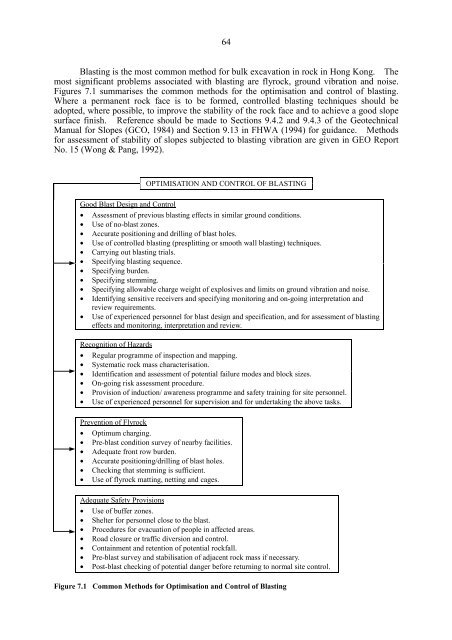Highway Slope Manual
Highway Slope Manual
Highway Slope Manual
Create successful ePaper yourself
Turn your PDF publications into a flip-book with our unique Google optimized e-Paper software.
64<br />
Blasting is the most common method for bulk excavation in rock in Hong Kong. The<br />
most significant problems associated with blasting are flyrock, ground vibration and noise.<br />
Figures 7.1 summarises the common methods for the optimisation and control of blasting.<br />
Where a permanent rock face is to be formed, controlled blasting techniques should be<br />
adopted, where possible, to improve the stability of the rock face and to achieve a good slope<br />
surface finish. Reference should be made to Sections 9.4.2 and 9.4.3 of the Geotechnical<br />
<strong>Manual</strong> for <strong>Slope</strong>s (GCO, 1984) and Section 9.13 in FHWA (1994) for guidance. Methods<br />
for assessment of stability of slopes subjected to blasting vibration are given in GEO Report<br />
No. 15 (Wong & Pang, 1992).<br />
ODTIMISATION AND CONTROL OF BLASTING<br />
Good Blast Design and Control<br />
• Assessment of previous blasting effects in similar ground conditions.<br />
• Use of no 叫 blast zones.<br />
• Accurate positioning and drilling of blast holes.<br />
• Use of controlled blasting (presplitting or smooth wall blasting) techniques.<br />
• Carrying out blasting trials.<br />
• Specifying blasting sequence.<br />
• Specifying burden.<br />
• Specifying stemming.<br />
• Specifying allowable charge weight of explosives and limits on ground vibration and noise.<br />
• Identifying sensitive receivers and specifying monitoring and on 叫 going interpretation and<br />
review requirements.<br />
• Use of experienced personnel for blast design and specification, and for assessment of blasting<br />
effects and monitoring, interpretation and review.<br />
Recognition of Hazards<br />
• Regular programme of inspection and mapping.<br />
• Systematic rock mass characterisation.<br />
• Identification and assessment of potential failure modes and block sizes.<br />
• On 叫 going risk assessment procedure.<br />
• Drovision of induction/ awareness programme and safety training for site personnel.<br />
• Use of experienced personnel for supervision and for undertaking the above tasks.<br />
Drevention of Flyrock<br />
• Optimum charging.<br />
• Dre 叫 blast condition survey of nearby facilities.<br />
• Adequate front row burden.<br />
• Accurate positioning/drilling of blast holes.<br />
• Checking that stemming is sufficient.<br />
• Use of flyrock matting, netting and cages.<br />
Adequate Safety Drovisions<br />
• Use of buffer zones.<br />
• Shelter for personnel close to the blast.<br />
• Drocedures for evacuation of people in affected areas.<br />
• Road closure or traffic diversion and control.<br />
• Containment and retention of potential rockfall.<br />
• Dre 叫 blast survey and stabilisation of adjacent rock mass if necessary.<br />
• Dost 叫 blast checking of potential danger before returning to normal site control.<br />
Figure 7.1 Common Methods for Optimisation and Control of Blasting

















